Greco di Tufo DOCG is a mesmerizing white wine produced exclusively in the vineyards surrounding the village of Tufo in the region of Irpinia (Avellino) in Campania. Give or take, it is about a ninety- minute drive inland from Naples. A clone of the Greco Bianco variety, Greco di Tufo delivers notes of lemons, pears and toasted almonds and a lingering minerality thanks to the volcanic ash from previous eruptions of Mount Vesuvius, and limestone tufa-rock found in the local soils.
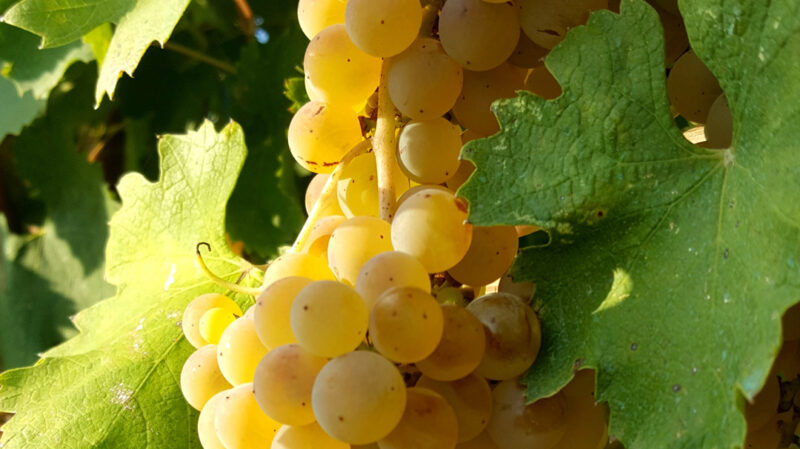
A cluster of Greco di Tufo grapes
The Greco grape has been around for centuries and is said to have been brought to Italy from Greece (thus the name). But it was Scipione di Marzo who first brought cuttings of Greco from his coastal hometown of Nola to replant in Tufo in 1647. At the time, the Kingdom of Naples and much of Southern Europe were beset by a plague. Scipione di Marzo sought refuge in the remote hills of Tufo.
Fortunately, both the health of Scipione di Marzo and the vine cuttings flourished in Tufo. Cantine di Marzo was officially registered with the Chamber of Commerce of Avellino as a Farm in 1833, thus resulting in being the oldest winery in Campania and among the oldest in Southern Italy.
Over time, the di Marzos acquired more land and built a large palazzo overlooking the valley of the Sabato river with a view of the Partenio mountains. A network of underground caves lies below the castle and the village of Tufo. The cellars are still used to produce Cantine di Marzo’s wines which are sold in more than 12 countries around the world.
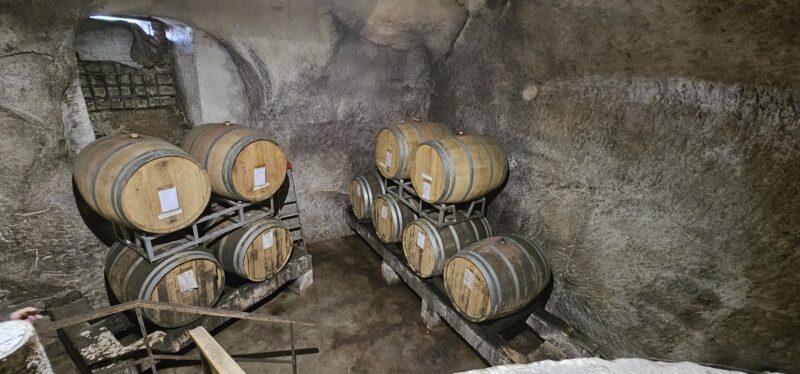
Cantine di Marzo’s ancient cellars
The discovery of sulfur mines in 1866 enhanced the family’s fortunes. Both their grape growing and sulfur mining and production also enriched the area. Tufo became an important settlement and center for trade. If you visit Tufo, remains of the mines and a large factory owned by the di Marzo family can be seen across from the old rail tracks used for transportation.
As the family increased in size it also grew in impact with some serving as members of the Italian parliament and others forming noble unions. For a time, several family members were involved in the oversight of Cantine di Marzo. Now this role falls under the direction of Ferrante di Somma, the 16th generation family owner, whose mother is a di Marzo and whose father is Filippo di Somma, the 15th prince of Colle.
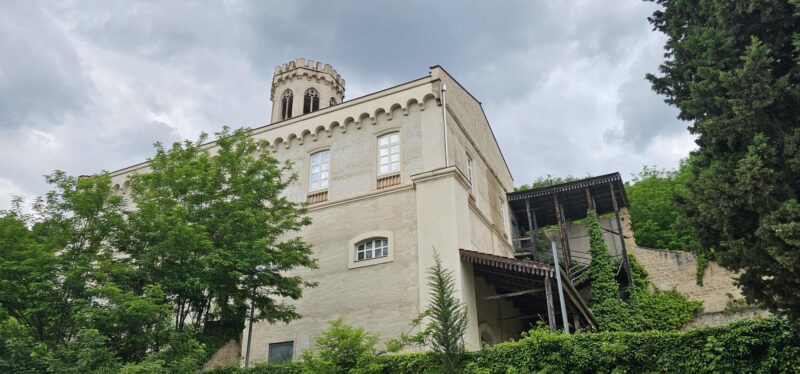
Cantine de Marzo Castle in Tufo
We visited Cantine di Marzo in May 2025 during Campania Stories, an annual program spotlighting the wines and regions of Campania. Eleanora and Simone, who both work for the winery took us on a tour. The estate owns 20 hectares of Greco di Tufo and Aglianico vineyards which are located at varying altitudes between 250 and 500metes above sea level. We visited three vineyards that produce Cantine di Marzo’s cru wines: Vigna Serrone, Vigne Laure and Vigne Ortale.
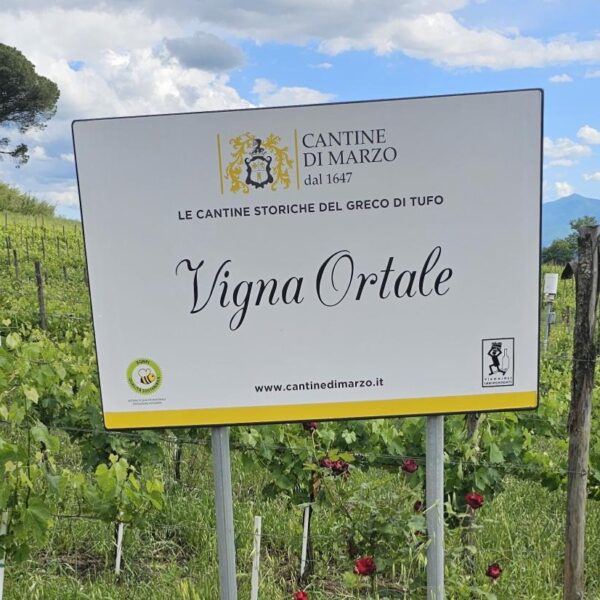
Vigna Ortale vineyard
Here is a selection of Cantine di Marzo Greco di Tufo wines we tasted.
Cantine di Marzi Greco di Tufo DOCG 2023. Grapes for this wine are sourced from different vineyards. The aromas are flint with deep citrus notes that carry through to the palate, along with nuanced flavors of blanched almond and Mediterranean flowers. This wine’s fresh acidity pairs well with oilier fish, fried calamari, antipasti and cheese.
Vigne Laure Greco di Tufo Riserva DOCG 2022. This vineyard is the highest at 440 meters and is located on a hill over the old sulfur mine. Soils are mineral and iron rich. This wine is crisp and structured with a hint of flint and well-suited for seafood dishes.
Vigne Serrone Greco di Tufo Riserva DOCG 2022. Vines are 20-50 years old and situated at 400 meters in clay and limestone soils. This wine has distinctive minerality, herbal and lemon-lime characteristics. Another great wine for pairing with seafood (all the Greco di Tufo wines do).
Vigne Ortale Greco di Tufo Riserva DOCG 2022. Soils in this vineyard are clay and calcareous, located at 420 meters. The wine rests on lees for nine months which delivers a complex, creamy and savory expression with notes of citrus and honey. Pair with all fishes, Thai and Vietnamese dishes.
Mulino Giardino Greco di Tufo Cru Riserva DOCG 2022. Grapes are sourced from the Torre Favale Vineyards, at 250 meters, which contain more volcanic matter in the soil. The wine rests 12 months on lees and is released two years after harvest. This wine delivered a nice blend of fruit forward notes mixed with lighter stony ones.
Didynos 2021. This wine is made in limited quantities, 800 bottles, and is an experimental Greco di Tufo. Whole clusters of Greco di Tufo are macerated, and the wine is aged in amphora for two and a half years. The wine has notes of saffron, honey and orange peel. Didynos means “twin.” Yes, a second twin red wine in in the works. This wine we brought back home to pair with curried seafood.
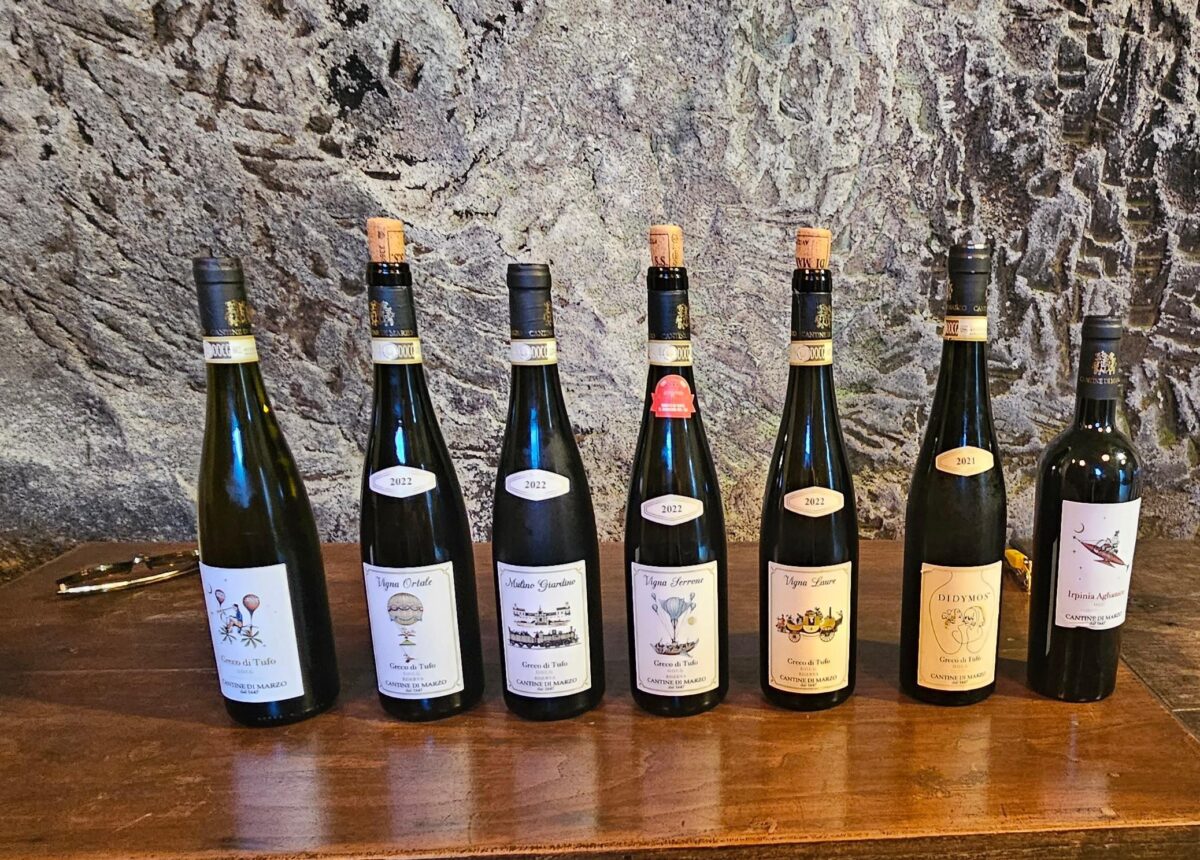
Other wines we tasted:
Taurasi DOCG 2020. Campania’s renowned Taurasi DOCG red wines are exclusively made in Irpinia from Aglianico varieties grown in a designated production zone. This wine is matured in French oak for 12 months and aged one additional year in bottle. It delivers classics characteristics of Taurasi wines: full-bodied with firm tannins, delivering notes of black cherry, dried blueberries and spice.
1930 Metodo Classico Brut Nature 2021: Another interesting fact about Cantine di Marzo is that its winemaker also introduced metodo classico sparkling wine production to Campania. This no-dosage wine is made from 100% Greco di Tufo and is crisp and citrusy. Its name honors the memory of family member, Filippo di Somma, who served as director of Cantine d Marzo for more than thirty years. For us, the zero dosage is a great aperitif and also idea for harder to paid dishes like artichokes and asparagus.

Ferrante di Somma
We met Ferrante di Somma at a reception hosted by Campania Stories and immediately connected with his debonair personality. He studied wine commerce in Burgundy and has lived in France, England and Russia. On The Connected Table Live, he discusses the history of Cantine di Marzo’s past, present and future – along with the family’s role in the production of Greco di Tufo on The Connected Table. Here is a link to the show
